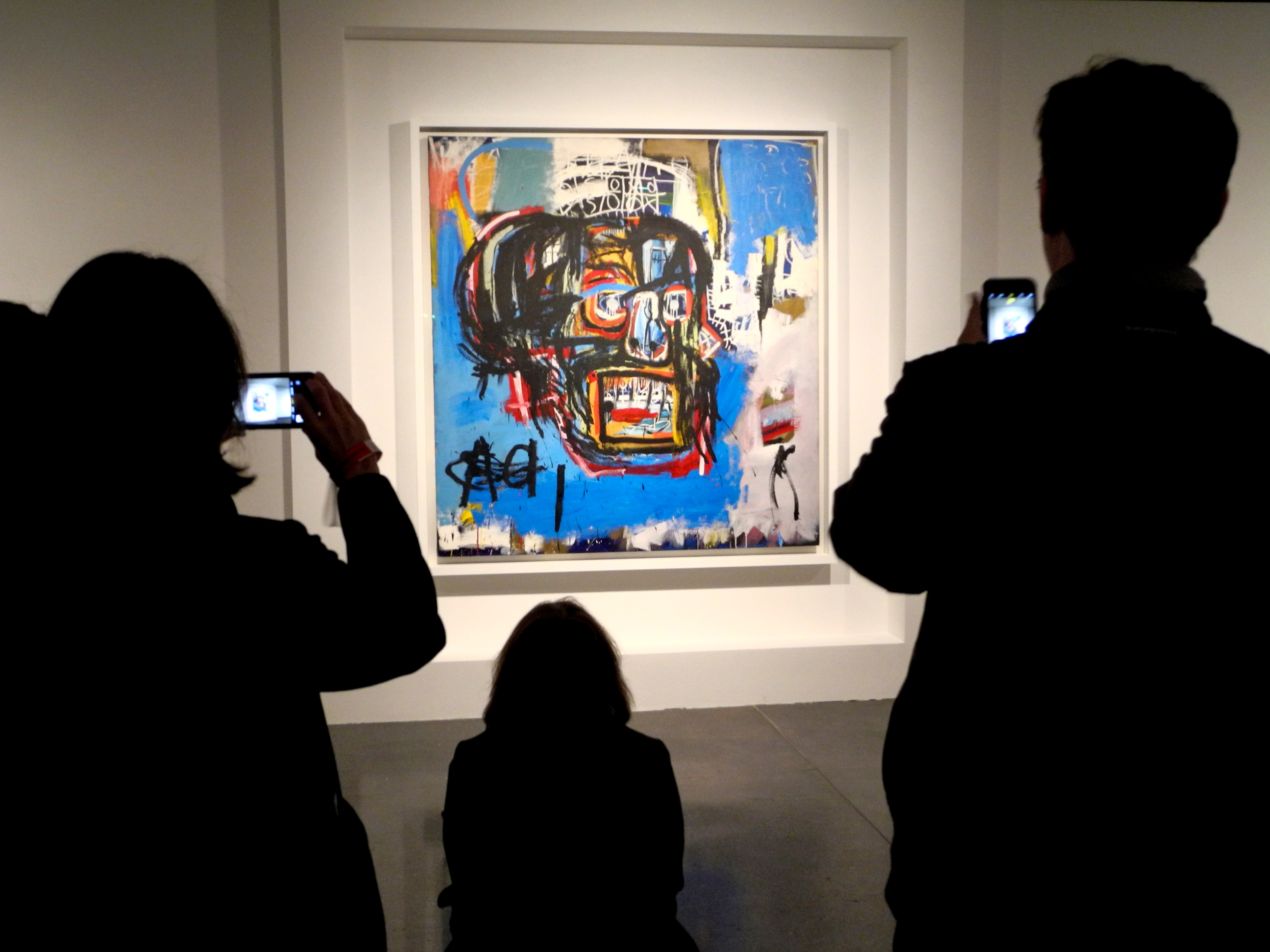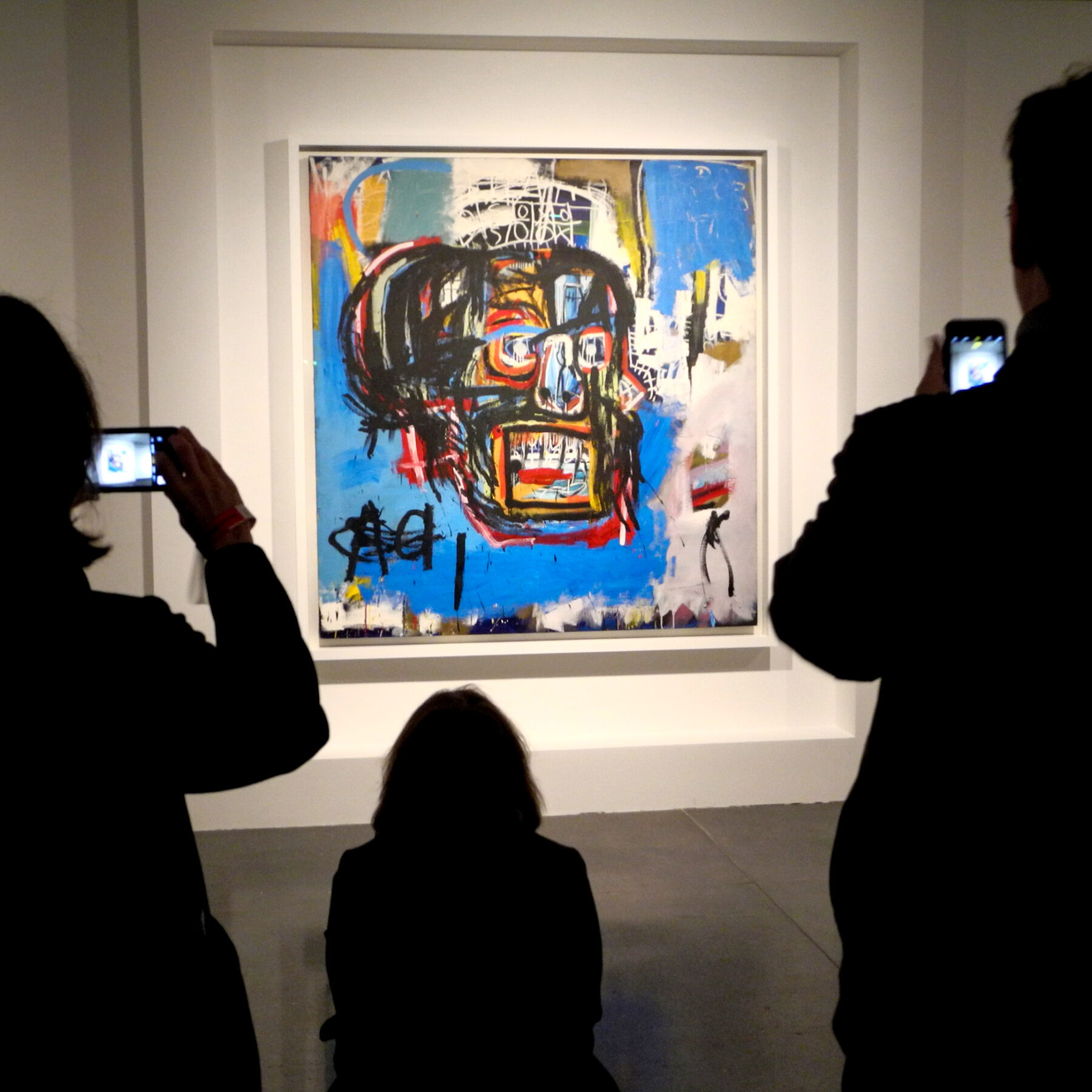New York’s contemporary art auction house Sotheby’s is hushed with transplants, tourists and collectors who never left. It’s May 18, 2017, and—as the story goes—auctioneer Oliver Barker is in motion, staring down a congregation of rising paddles and formal attire. There’s a cool rhythm to his work: dollar amount, stare, dollar amount, stare, sold.
With a final call and gavel fall from Barker, the deal is sealed. Just like that, Brooklyn-born artist Jean-Michel Basquiat’s 1982 art piece Untitled is sold, for a record-breaking USD $110.5 million, to Japanese billionaire Yusaku Maezawa. The piece—which features a fragmented skull with broken teeth, distorted near the left eye and back of the head, rendered in raw, grim colours that evoke a sense of rot and decay—became the highest price ever paid at auction for artwork by an American artist in a public sale. Forged from acrylic, oil sticks and spray paint, at this juncture, the Basquiat of can-painted strokes, signature tags and graffiti-walled beginnings is undeniable.
“It was bittersweet when curators and directors from institutions like the Museum of Modern Art witnessed his rise,” says Basquiat’s fellow band member and filmmaker friend Michael Holman. “His art initially held zero value to these people. They wouldn’t even accept free pieces because he was a Black artist who seemed wild and crazy, and made art that wasn’t always easy to decipher and understand. They were too afraid.”
Basquiat was 21 when he painted Untitled, making him the youngest artist to eclipse the $100 million mark. In roughly seven years, he would go from tagging up public walls to being led past velvet ropes as one of the most branded and commercialized artists of our modern times.
His art, much like the works of others with walled city beginnings—be it in the U.S., Canada or elsewhere—became rallying points for the kinds of people they were actually about: Black folks or, more broadly, the disenfranchised. For others, particularly during the height of Basquiat’s fame, his pieces were status symbols, roused from the contours of his strokes.
“Street art,” as it’s known today, occupies a similar middle ground between the uppity world of art galleries and the defiant underworld of graffiti runners. It’s a visual language that varies from city to city but shares ties to anti-establishment ideas. By design, art on the street screams culture, and the world has never been more adept at embracing—but also exploiting—this culture at scale.
“If we were talking about this several years ago, some of the inevitable success we’ve seen would have been known as selling out,” notes Holman, who met a teenage Basquiat in the 1970s when he was one-half of the elusive graffiti duo SAMO (short for “same old shit”). But it couldn’t be stopped; something was clicking in the minds of spearheading creatives like Jean all over the world right close to the Vietnam War.
“You didn’t want to be erased, forgotten or overlooked, whether you were Black, Puerto Rican or felt abandoned by your city,” adds Holman. “You bombed every street line with expression, and it was so different that others around the world wanted in on it.”
Grassroots cultures like punk, hip-hop and graffiti were given the rah-rah to take the world by storm. In the 1970s and early 1980s, these scenes meshed, remixing into new forms and spawning a breed of not-so-legal artists, best exemplified by Basquiat, England’s Banksy, and Vancouver’s Richard Hambleton.
By 1973, New York, like other cities worldwide, was emptying its wallet annually in an attempt to control graffiti vandalism, with hundreds of graffiti-related arrests made. Similarly, in Toronto, community investment programs like the Graffiti Transformation Program, introduced in 1996, emerged in efforts to repaint walls with attractive murals.
Holman explains that graffiti became a competitive arena where artists vied to establish their names and influence on the streets. “No matter where you lived, it was hard to control, because graffiti became this social hierarchy,” he says. “It became a competition.”
Meanwhile, outlets like the New York Times were busy profiling the champions of this movement, such as young graffiti writer TAKI 183 in 1971, which only served to spread unauthorized art faster. And by nature of it being public, street art was bound to find an audience with the deepest of pockets sooner rather than later. Initially seen as mere vandalism, street art’s rebellious and unconventional origins transformed it into a sought-after symbol of sophistication and exclusivity. The scarcity of works by leading artists and their avant-garde appeal only added to the idea that they were coveted enough to be status symbols for what’s new and cutting-edge.
In February 1981, the fine art world finally took notice of a chosen few from the underground with the “New York/New Wave” exhibition at MoMA PS1 in Queens, New York. Curated by American filmmaker Diego Cortez, the show featured works by emerging artist Basquiat alongside established figures such as Andy Warhol and Robert Mapplethorpe.
“The success or notoriety of these artists, regardless of their origin, came from their ability to appeal to different groups of supporters over time,” says Grégoire Billault, chairman of contemporary art, New York at Sotheby’s. “A new generation always sought something different, and markets continue to shift with generational change—a factor that many undoubtedly benefited from on both sides.”
This boon reached figures like Puerto Rican-born Lee Quiñones, whose once illegal paintings of lions, dragons and Howard the Duck on underfunded train cars in New York City in the 1970s and early 1980s contributed to his prominence.
“I remember suddenly being in the spotlight,” says Quiñones, whose art has found its way into the collections of several major museums, including the Galleria La Medusa in Naples, Italy, and the Whitney Museum of American Art in New York City. “I met all kinds of new and diverse artists, especially in music and poetry. It was welcoming, but honestly, also kinda strange. I was just happy to be seen.”
Despite the frenzy of success, Quiñones feels that the rush to own street art over the decades has been tainted by greed. He says, “Today, street art seems like it serves both as an economic flag and a marker of gentrification. If street art is appearing in a neighbourhood, for example, chances are it’s the next area to live in.”
In other words, some museums, retailers and governments have mastered the art of tying themselves with graffiti artists to obscure the ultimate sin of being out of touch. Others have simply reaped the rewards for appearing trendy and progressive.
In the case of Basquiat, Amazon and Gap—among other big-box retailers—are in on the action, offering clothing splashed with his artwork. But if wearing his pieces isn’t enough, fans can also deck out their iPhones or even challenge friends to a Basquiat-themed edition of Uno. Despite this commercial boom, Basquiat’s estate, which is managed by his siblings Jeanine Heriveaux and Lisane Basquiat, has been entangled in legal battles with the IRS over inflated valuations of his collection, leading to substantial tax disputes. As a result, financial gains are often offset by the high costs of maintaining and defending his legacy, highlighting a complex balance between cultural influence and the commercial realities of his work.
“You can’t stop billionaires from adopting these works for their businesses or their billionaire friends in some bat cave somewhere,” notes Nick Mount, a professor at the University of Toronto who is currently writing the first international history of vandalism. “The artists have historically benefited even when the art wasn’t appreciated, but I think what’s been lost in the merchandising of art that originated on walls is its use as a civic conversation in our streets.”
For a long time, this is what the street art scene was, as Mount remembers it: public artists tagging up buildings or beautifying their blocks with unrest. Their universe was either a communal affair with the like-minded or a series of chases.
But street art now, more than ever, is unmistakably a business, not just a rebellious form of expression, and artists are the entrepreneurs. “Fundamentally, what many of us do is still public art,” says Toronto-based multidisciplinary artist and muralist Danilo Deluxo, best known for his work on the much-rested-on three-dimensional Toronto sign in the downtown core’s Nathan Phillips Square.
Get the
Three from 3
newsletter
Join our global community of sharp, curious thinkers to receive a carefully curated email of the three most important things to read, see and do this week.
Listen and learn.
Tune into Third Culture Leaders, a podcast hosted by our co-founder and publisher, Muraly Srinarayanathas.
Explore how leaders skillfully navigate multiple cultural landscapes, leveraging their diverse backgrounds to drive innovation and change.
“Former street artists like myself played our roles in creating the art economy we now have, but I still consider what we do a service to the public more than anything,” he adds.
Deluxo sees the growing interest in street-style art from collectors, public billionaires, businesses and spaces as a foregone conclusion—something that can’t and, perhaps, shouldn’t be stopped. Though artists like himself are finding more opportunities to cover sanctioned walls, there’s always a constant tug-of-war between personal ideals and paid rent.
“You have to create a marriage between your style, what’s accepted, and what resonates with people, which now brings funding,” adds Deluxo. “That success can still impact others, but it’s not entirely yours, so you come to grips with that.”
Like other street artists, Deluxo, whose work champions Black identity, wonders if his murals will remain. Either way, he believes his work will have served its purpose. It made a person of colour feel seen. It made a passerby appreciate a moment of psychedelic beauty within a city in transition. And it brought a little more culture and identity—however you choose to define the art itself—to the very people it’s meant to represent.

